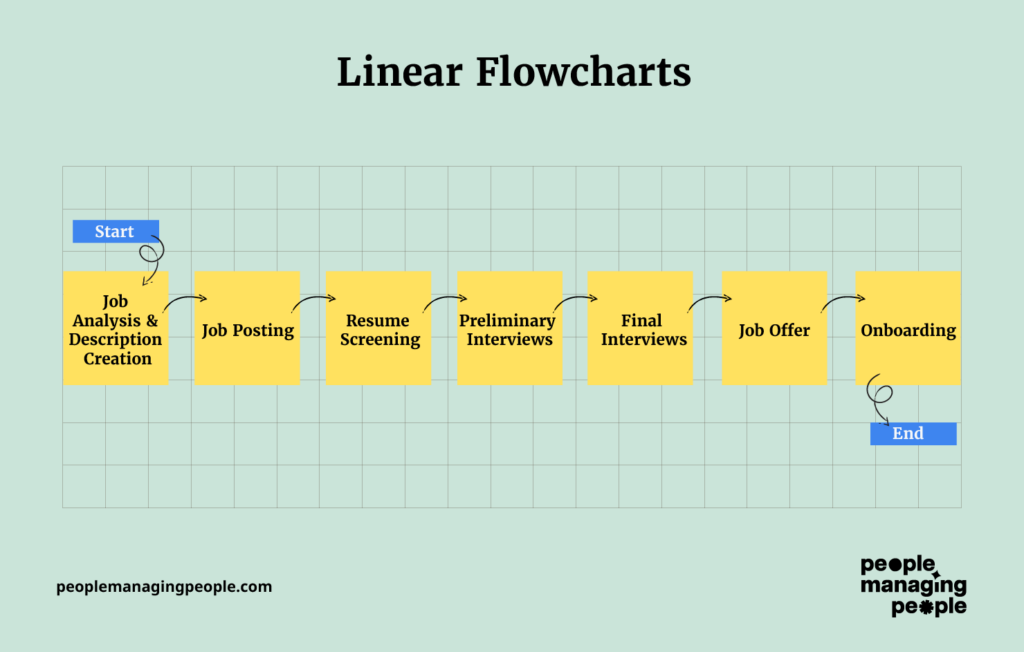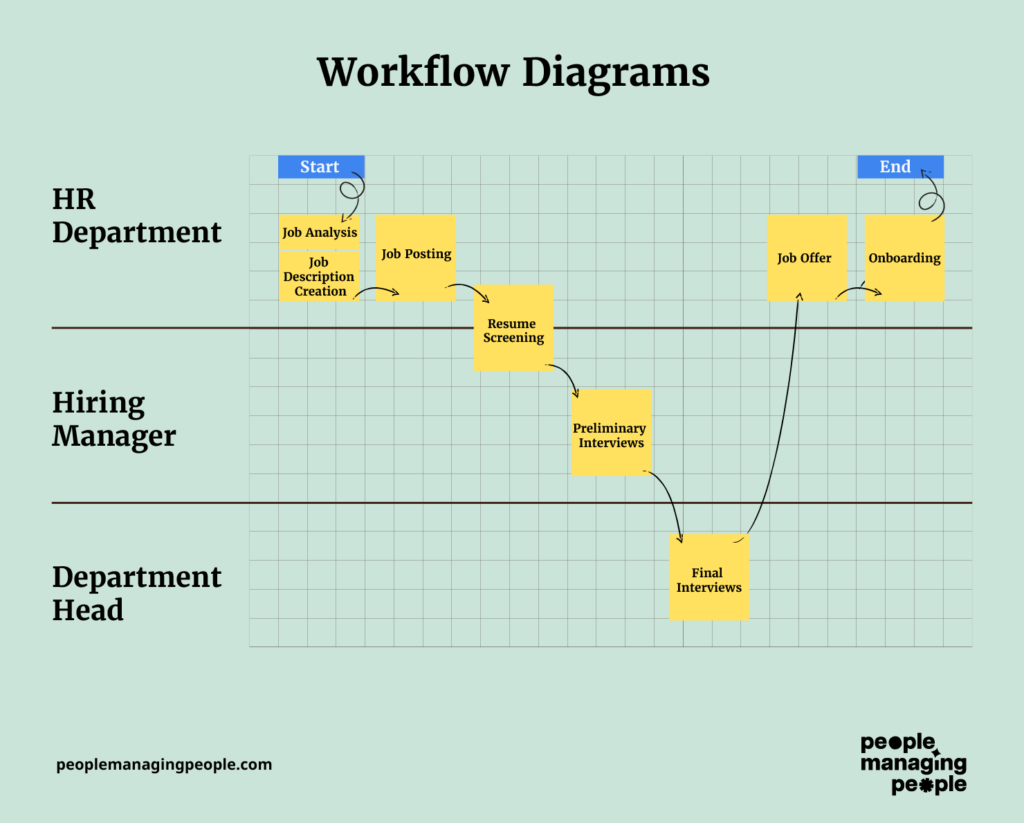Streamline Your Hiring Game: A structured recruitment process helps organizations efficiently attract and retain top talent, ensuring that every step is purposeful and effective.
Flowcharts: Your Hiring Best Friend: Implementing a recruiting process flowchart can simplify complex hiring steps, visualize workflows, and enhance communication among team members.
Visualize to Optimize: Using flowcharts in recruitment aids in identifying bottlenecks and improving the overall process, making hiring more efficient and enjoyable for everyone involved.
A structured and efficient recruitment process is crucial for attracting and retaining top talent. To create an efficient recruitment process, using recruitment CRM tools can automate and simplify candidate relationship management. One powerful strategy that can enhance the hiring process is a recruiting process flowchart.
This guide will walk you through the steps of creating a recruiting process flowchart, explaining its benefits, key components, and how it can streamline your hiring efforts.
What Is A Recruitment Process?
A recruitment process is the series of steps an organization takes to identify, attract, screen, interview, and hire the best candidates for a job. It involves everything from understanding the job requirements to onboarding the new hire.
A well-designed recruiting process should incorporate recruitment database tools for a smooth and organized hiring workflow.
Having a structured recruitment process is essential because it ensures consistency, reduces hiring biases, and helps in attracting the right talent efficiently.
What Is A Recruiting Process Flowchart?
A recruitment process flowchart is a visual representation of the steps involved in the recruitment process. It outlines each stage of hiring, from job analysis to onboarding, in a clear and structured format and can prove to be as useful as a recruiting software in helping you streamline the process.
Okay, maybe not that useful, but the purpose of using a flowchart in recruitment is to provide a roadmap that helps recruiters and hiring managers understand and follow the process efficiently.
A flowchart visually maps out the recruitment process, making it easier to identify each step and understand how they are interconnected. Flowcharts can vary in style, from simple linear designs that represent a straightforward sequence of steps, to more complex swimlane charts that show the responsibilities of different departments or team members.
Later, we’ll dig into a few of these examples, but first, let’s break down the recruitment process to see what needs to be accounted for in our flowchart.
Steps In The Recruiting Process
Job analysis and description
Creating a precise job description is the foundation of an effective recruitment process. It’s essential to define the role and its requirements clearly. but is often something companies get wrong.
According to a survey from Skynova, only about half of the job seekers they surveyed said that job postings actually paint a clear picture of the job, while 16% say that it's rare for a job to be described effectively.
Start by analyzing the job, identifying key responsibilities, and determining the necessary skills and qualifications. A well-crafted job description not only attracts the right candidates but also sets clear expectations for the role.
Sourcing candidates
There are several methods to source candidates, including job boards, social media platforms like LinkedIn, and employee referrals. Each method has its pros and cons.
For instance, job boards can reach a wide audience, but may result in a high volume of unqualified applicants. Employee referrals often yield high-quality candidates, but may limit diversity.
Understanding the strengths and weaknesses of each method helps in choosing the most effective sourcing strategy for your organization. You can use candidate sourcing software to help you identify channels and compare their effectiveness.
Screening and shortlisting
Initial resume screening is crucial for filtering out unqualified candidates. Integrating an AI recruiting solution can help streamline data collection and parsing of resumes by scanning for keywords, matching skills, and transforming large volumes of data into digestible chunks.
After screening, conduct preliminary interviews to further narrow down the candidate pool, ensuring that only the most suitable candidates move forward.
Bonus: HR background check solutions simplify the process of mapping out an effective and thorough recruitment workflow.
Conducting Interviews
Prepare structured interviews with a mix of behavioral, situational, and technical questions and determine which sort of employment testing method will be most effective for measuring skill aptitude for the role. This approach ensures a comprehensive assessment of the candidate's skills, experience, and fit for the role.
Making the Hiring Decision
When evaluating candidates, it’s important to involve multiple team members in the decision-making process to ensure a balanced and unbiased evaluation. Team consensus through a collaborative hiring process can help in selecting the candidate who not only meets the job requirements but also aligns with the company’s culture.
Automated tools, such as Applicant Tracking Systems (ATS), can help speed up this process.
Onboarding
Onboarding is the final, yet one of the most critical, steps in the recruitment process. A smooth onboarding process helps new hires acclimate to the company culture, understand their role, and start contributing effectively.
Types Of Recruiting Process Flowcharts
In creating a flowchart for your recruitment process, there are a few different approaches you can take. Here, we’ll break down a few of the most commonly used flowcharts and provide an example of each.
Linear Flowcharts
Linear flowcharts provide a simple, step-by-step representation of the recruitment process. They are best used in straightforward hiring scenarios where the process follows a clear, sequential path.
For example, a linear flowchart might be ideal for small businesses with a simple recruitment process that only involves an HR person and a hiring manager.
A linear flowchart will look a bit like this.

Swimlane Flowcharts
Swimlane flowcharts represent responsibilities across different departments or team members. These flowcharts are particularly useful in complex recruitment processes that involve multiple stakeholders.
For instance, in larger organizations where HR, hiring managers, and department heads all play a role in the recruitment process, a swimlane flowchart helps clarify who is responsible for each task.

Workflow Diagrams
Workflow diagrams offer a detailed breakdown of tasks and activities within each recruitment phase.
These diagrams are ideal for organizations that require a more granular analysis of their recruitment process. They help in understanding the intricacies of each step and ensuring that all tasks are completed efficiently.

Customizing the Example
When customizing the flowchart for your organization, consider your hiring strategy and the specific roles and industries you are hiring for. Tailoring the flowchart to reflect your organization’s needs ensures that it is practical and relevant.
For instance, a tech company might include additional steps for technical assessments or coding tests, while a creative agency might focus more on portfolio reviews and creative briefs.
Are you open to referrals from other employees? Maybe you're recruiting heavily on social media. Whatever your strategy is, it also needs to be accounted for in the flowchart, particularly if it involves an additional stakeholder.
How Does A Flowchart Benefit The Recruitment Process?
- Improved clarity and efficiency - allows recruiters to visualize each step in the recruiting funnel and ensure nothing is overlooked.
- Enhanced communication - helps communicate some of what is found during a recruitment audit by outlining each person's responsibilities, creating a sequence of tasks and explaining the recruitment process to stakeholders, such as hiring managers or executives.
- Identifying bottlenecks - recruiters can easily identify stages where delays occur and address inefficiencies.
Using Your Recruiting Process Flowchart
Implementing the flowchart
To effectively implement the flowchart, integrate it into your recruitment process by training the hiring team on its use. Ensure that everyone understands how to follow the flowchart and the significance of each step. This training will help in maintaining consistency across the recruitment process.
Monitoring and updating
Regularly review and update the flowchart to reflect any changes in the recruiting process. Gathering feedback from the hiring team can provide valuable insights into how the flowchart is working in practice and where improvements can be made.
Measuring success
Track key metrics to assess the effectiveness of your recruiting process flowchart. Metrics such as time-to-fill, cost-per-hire, and candidate satisfaction can provide data-driven insights into how well the flowchart is working.
Use this data to refine and optimize the flowchart over time, ensuring it continues to meet the needs of your organization.
Want to keep up with all the latest trends and insights from the world of recruiting? Sign up for the People Managing People newsletter and you'll get expert tips and curated content straight to your inbox.



